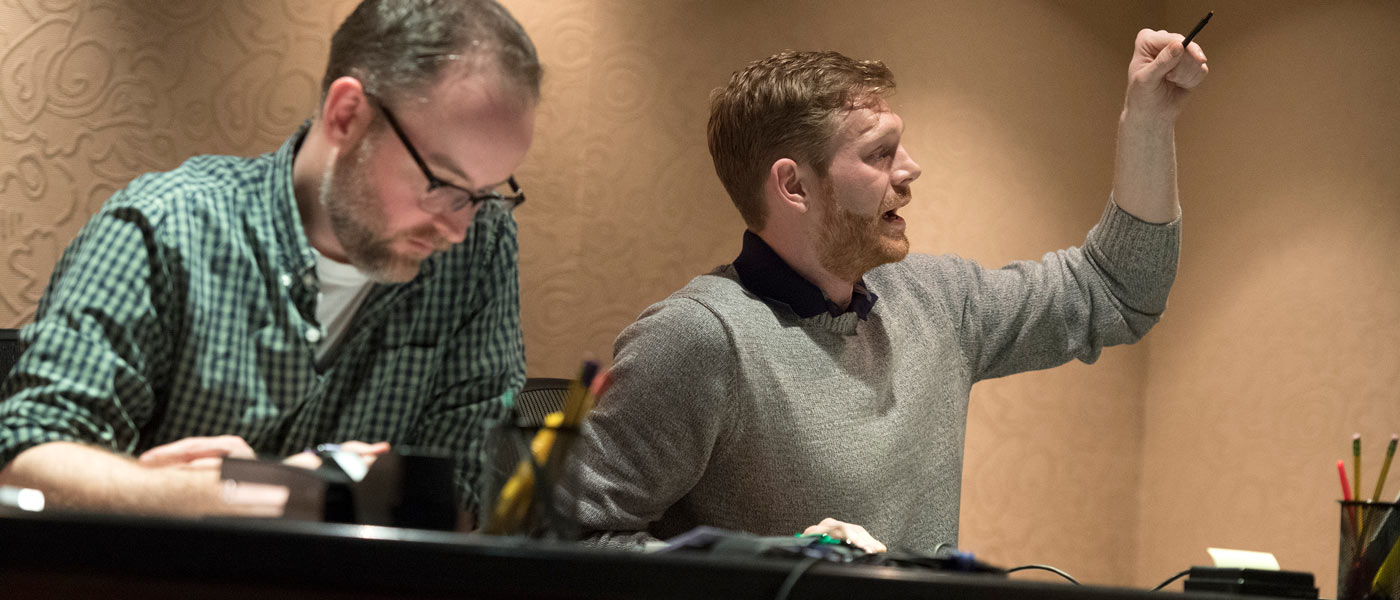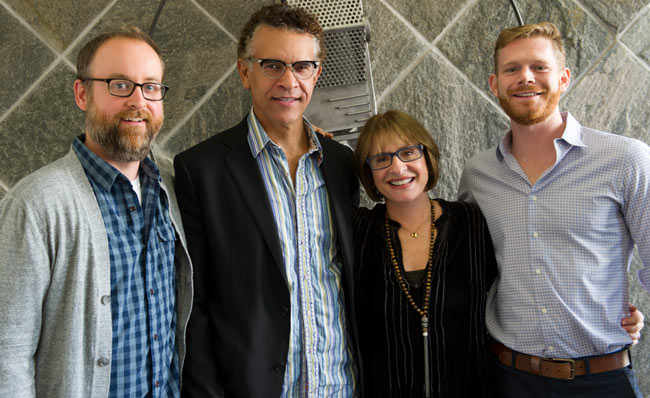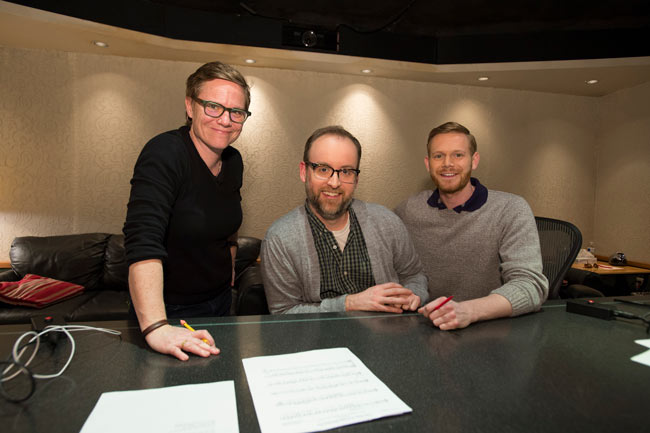
Over the course of the last few years, we have had the privilege of serving as songwriters for the Disney Junior animated TV series “Vampirina,” which follows a family of friendly vampires who have recently moved from their home in Transylvania to Pennsylvania. By the end of the show’s second season, we will have written 100 songs.
As lifelong Disney nerds, this opportunity has been a dream come true. We’ve had the chance to work with an amazing cast featuring some of our childhood voiceover heroes like Cree Summer, as well as a number of Broadway icons such as Patti LuPone, Brian Stokes Mitchell and Christian Borle.
Needless to say, however, for theatre songwriters who had never previously written songs for the screen, the learning curve we faced at the start was rather steep.
We’ll surely continue to learn and grow as this process continues, but we wanted to share a few of the lessons that we’ve learned along the way, particularly the ones that we feel can be applied to our work for the stage.
SPEED
Perhaps the most obvious difference between theatre and television is the rate at which the process occurs. It can take a brutally long time for a stage musical to see the light of day. The upside of that is that you often have five to ten years to get a song right.
Not so in television. With the realities of the production schedule for putting together 25 animated episodes, each of which features two original songs, we typically have roughly ten days to write and produce demos for the first drafts of two songs. If revisions are necessary, they often must take place on a similar timeline.
That sort of schedule can be anxiety-inducing, but it also forces you to sharpen your skills as a songwriter. We’ve really expedited our writing process, ironing out a lot of the roadblocks that could delay our process. There’s simply not time for it. You’ve got to be as efficient as possible.
This sort of efficiency has been invaluable in our theatrical work, particularly in a workshop or reading setting. We’re able to address issues much more quickly now, and are often able to turn around revisions or new songs within the course of a workshop that probably would not have been possible previously.
NOTHING IS PRECIOUS
Another of the advantages of writing so many songs so quickly is that it ingrains in you a firm sense of never holding any of your work as precious. It can be really dangerous as a writer to fall so much in love with a particular song that you lose sight of the fact that it may not be serving the story as well as it should be. This can be an especially difficult trap to fall into when the song in question has been a part of the show for years.
It’s a lot less painful to make changes to (or start from scratch on) something that you’ve only lived with for a matter of days or weeks. The sheer volume of material makes it even easier. You simply don’t have the luxury of getting too attached to anything, and that allows you to look at the work from a much more objective, critical perspective.
We’ve revisited a number of projects recently, and have worked to apply that same ruthless critical eye. The work has definitely improved as a result.
Recording session. Christopher Dimond, Brian Stokes Mitchell, Patti LuPone, Michael Kooman.. (Disney Junior/Paula Lobo. © 2016 Disney Enterprises, Inc. All rights reserved.)
TAKING NOTES
Anyone who has spent any time writing for the theatre knows that in such a collaborative art form, you’re going to receive feedback from a seemingly endless number of sources. Learning how to deal with other people’s opinions of your work can arguably be one of the most difficult things to deal with, particularly early in your career.
Writing for television is all about taking notes and effectively incorporating them into your work. As a writer for the theatre, it can be tempting to indulge the knee-jerk reaction of “I’m the writer, so I don’t have to listen to anyone else.” In TV, that sort of ego-driven reaction can be a great way to get fired.
Learning how to take a note, identify the underlying issue that the person is responding to, and respond in a way that addresses the issue while maintaining your vision for the song can be difficult, but it pays huge dividends in the long run, far beyond the individual song in question.
ORGANIZATION & TIME MANAGEMENT
These may seem like skills unrelated to writing, but this process has sharpened our organizational and time management skills in ways that have had an unexpected impact on our theatrical work and our careers in general.
On “Vampirina,” our responsibilities include not only writing the songs for the show, but also serving as musical producers. As such, we oversee a team of orchestrators, mixers, demo singers, and audio engineers as we create the demos and instrumental tracks for the songs; run the vocal recording sessions with the show’s cast; edit and produce the final mix of the songs; and organize and deliver all of the associated materials to the sound and animation teams.
These aren’t things that we were used to being responsible for, but doing so has helped us develop skills that have proved useful in the theatrical realm as well. We’re much better in the recording studio than we used to be, we are far more organized in everything from our communication to data management, and we’re generally more efficient and confident in our producing abilities.
Those may seem like minor details, but they’ve definitely made a difference in terms of saving time, eliminating miscommunication and stress, and streamlining our workflow in many of the non-writing related elements of the theatre business.
PRODUCTIVITY
At the start of the first season, the idea of writing and producing fifty songs for one project sounded virtually impossible. Thankfully, the experience of doing so was so intense that we rarely had the opportunity to step back and think about how daunting it was. By the end of the season, we were shocked at how much content we had been able to create in a relatively short amount of time.
That’s one of the big things that we’ve made a conscious effort to carry into our other projects. You’d be amazed how much you can accomplish when you’ve got an ambitious goal on a tight deadline. True, it’s often easier when the deadline is external, but we’ve been striving to hold ourselves to the same standard in terms of how hard we work on our self-driven theatrical pieces as well.
As a writer, being your own boss can be a blessing and a curse, and it’s good to remind yourself every now and again just how prolific you can be if you really push yourself.
Chris Nee, Christopher Dimond, Michael Kooman. (Disney Junior/Aaron Poole. © 2017 Disney Enterprises, Inc. All rights reserved.)
Michael Kooman, Isabella Crovetti, Chris Nee, Christopher Dimond. (Disney Junior/Aaron Poole. © 2017 Disney Enterprises, Inc. All rights reserved.)
BREVITY REALLY IS THE SOUL OF WIT
One of the quirks of writing songs for an animated children’s series is that the form is, by necessity, short. Each episode of “Vampirina” is split into two 11-minute stories, and each of those stories features a song, which tend to be around one minute each.
Prior to this experience, we had never written a one minute song, and the assignment to do so seemed almost ludicrous at the outset. Early on, we struggled to meet that requirement.
However, having been forced to do so repeatedly, we’ve found that we’re able to be much more concise in our work nowadays, and not just for “Vampirina.” Obviously we’re not writing too many one-minute songs for our stage projects, but we’ve found that exercising those muscles has helped us to focus our songs and get to the point far more efficiently and effectively than we used to.
TRUST YOUR AUDIENCE
This is one that we like to think that we knew coming in, but going through the process of writing for such a specific demographic has certainly deepened our understanding of the danger of underestimating your audience.
One of the traps of writing for young audiences in any form is to write down to them. Our brilliant showrunner Chris Nee is constantly pushing us to challenge the kids who watch the show, to trust that they’re more astute viewers than some may be inclined to give them credit for.
Similarly, it can be tempting when writing for adults in musical theater, where clarity is paramount, to want to make sure that you “idiot-proof” the material. The danger, of course, is that you spell everything out for the audience, and don’t let them actively engage with the material in the way that they want to.
STRUCTURAL FLEXIBILITY
We’re huge fans of structure. Always have been. Always will be.
One of the challenges of writing a one minute song, however, is that it’s pretty impossible to fit a traditional Verse/Chorus structure in there, especially if you want to include a bridge. And, if you have to write 50 of them, you definitely don’t want them all to fall into a tight AABA form.
That parameter has forced us to stretch the types of forms that we use in our songs, making use of non-traditional structures that we might not have considered previously. We’ve experimented quite a bit, and have been thrilled with the results, carrying a renewed openness to less traditional forms into our stage work as well.
VARIETY WITHIN A CONSISTENT WORLD
One of the many exciting challenges we faced as we embarked upon writing the songs for the first few episodes of “Vampirina” was defining exactly what the musical world was. The writers had created a super specific, spooky, fun world filled with lovable monster characters of all shapes and sizes. We had a blast figuring out what the sound of that world was.
Within that world, we obviously wanted to keep a consistent tone to the music. However, we knew that ideally, we’d be writing hundreds of songs over a number of years for these characters, and we certainly didn’t want to limit or repeat ourselves.
So, we’ve been continually working to stretch the musical palate of the world, to find as much variety as possible in the types of songs that we use, while still staying true to the heart of the musical world.
While no stage musical will involve the breadth of songs that a multi-season TV series requires, we’ve tried to approach our theatrical work with a similar mindset. We want to make sure that we’re carving out clearly-defined, specific, unique musical worlds, while allowing for enough variety to keep the audience continually entertained and surprised.
THE SKY’S THE LIMIT
Perhaps the greatest joy of writing for animation is that, in a cartoon, absolutely anything can happen. You’re not hampered by the practicalities of what can actually occur on stage in front of a live audience. You want a character to fly? No problem. Change locations instantaneously? Sure. A singing cast of thousands of characters? Well, there may be some limitations, but you get the point.
All too often when writing for the stage, it can feel natural to nip an idea in the bud because you can’t necessarily visualize how a director would make it work, or it’s simply impractical because of the economics and physical restraints of the theater. Worse, you may find yourself questioning the wisdom of pursuing a particular project that may, on the surface, seem to make for an impractical theatrical venture.
Stretching your imagination in the way that animation allows is in and of itself an inspiring creative exercise. It’s freeing to break loose from practical restrictions and to see a talented team of animators go even further than you initially imagined.
We’re trying to take that sort of uninhibited imagination and apply it to our works for the stage as well, freeing up our imaginations to run wild, and finding creative solutions for the resulting challenges later.
Want to learn more about Kooman & Dimond’s stage work? Click here for Kooman and here for Dimond.

Noël Coward’s Travels

Kate Chopin in New Orleans: Mother-Daughter Author Duo Collaborate on Historical Book




